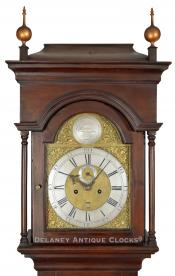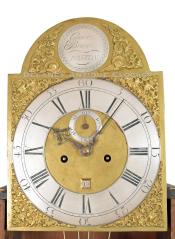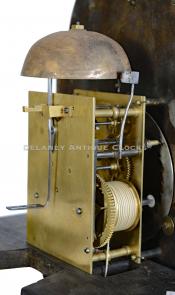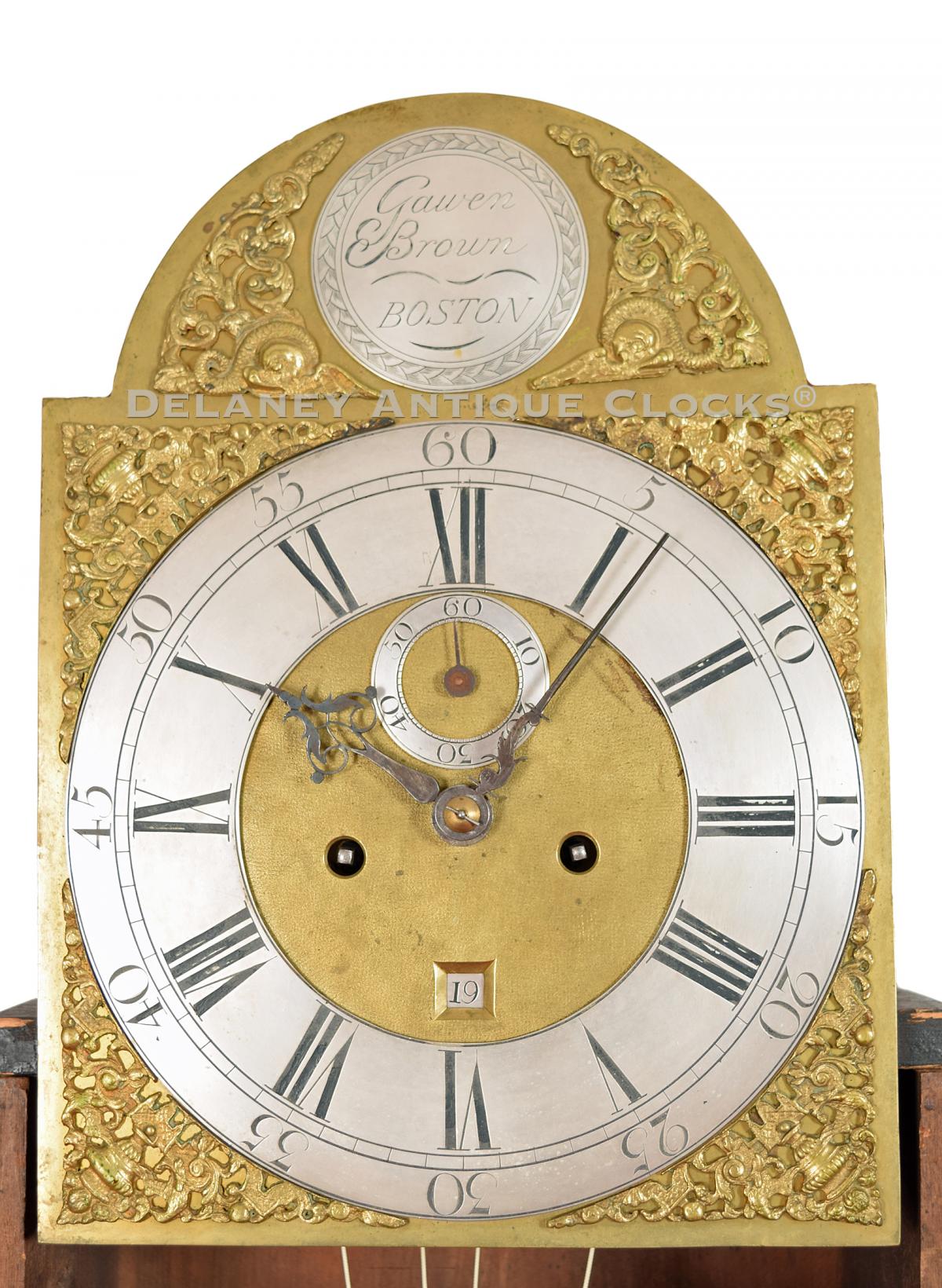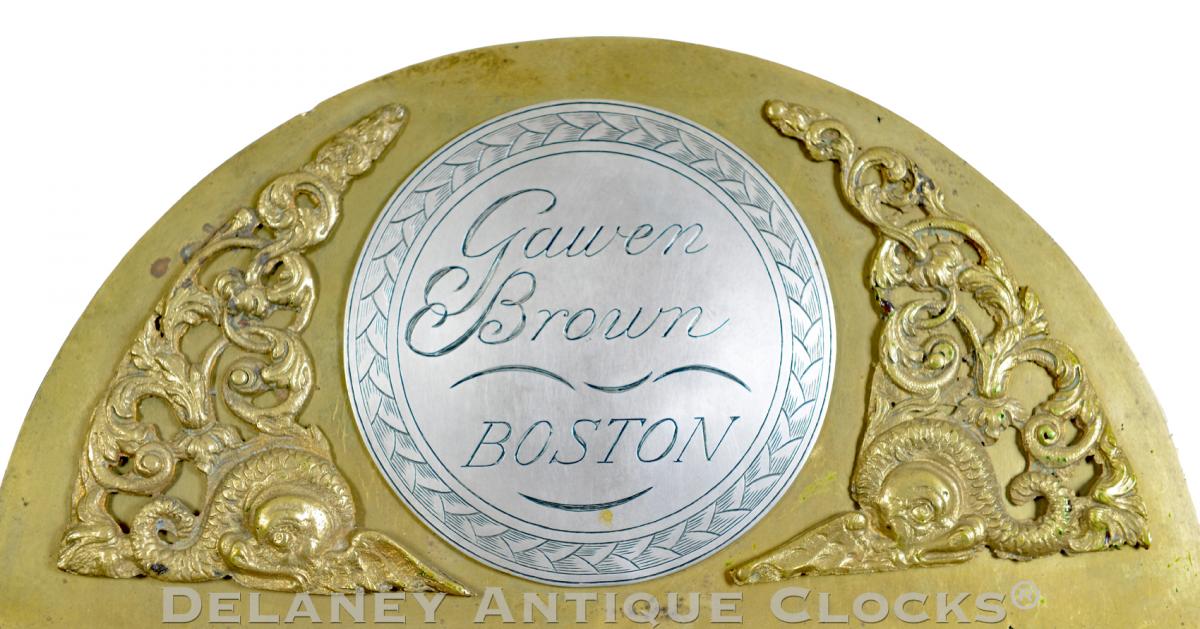Gawen Brown. Boston, Massachusetts. A pre-revolutionary American tall clock. UU-99.
Gawen Brown of Boston, Massachusetts, made this important maple case tall clock. Circa 1755.
This rare clock is typical of the early Boston form. The case is maple and stained with a dark tint to look like walnut. The color is excellent. The case is supported on a large double-step molding that rests flat on the floor. The molding that transitions the base to the waist section is complex. The waist section is filled with a tombstone-shaped door that provides access to the two drive weights and brass-faced pendulum bob. The bonnet features a caddy top with two gilt wooden finials. Free-standing columns flank the hood door and visually support the arch molding. Shaped quarter columns are fitted in the back corners of the hood. The hood sides have large rectangular-shaped windows that are glazed. Through these, one can view the clockworks. The bonnet door is arched in form and opens to a composite brass dial signed by the Maker.
This style of dial predates the painted dial. It comprises a brass base sheet decorated with applied spandrels and chapter rings. This clock is signed "Gawen / Brown/ BOSTON" on the name boss in the arch of the dial. The large chapter ring is also applied to the dial. Arabic five-minute markers are indicated in each of the hour positions. These are separated from the Roman-style hour numerals by a closed minute track. The center of this section is nicely matted. This was likely done to aid in one's ability to locate the hands while reading the dial. A brass dial will tarnish over time, making it somewhat difficult to read in a room lit by candles. This dial also features the subsidiary seconds dial and a calendar display. These are engraved and silvered. The steel hands are wonderfully made.
The movement is constructed in brass and is weight-driven. It is designed to run eight days on a full wind and strike each hour on a cast iron bell. The bell is mounted above the movement.
This case stands 7 feet 8 inches tall overall. The upper hood molding is 21.5 inches wide and 10.25 inches deep.
Inventory number UU-99.
Gawen Brown was born in England in 1719 and died in Boston, Massachusetts, at the age of 82 in 1801. He came to this country sometime before 1749. That year, on February 6, he advertised in The Boston Evening Post that he was a "...Clock and Watchmaker lately from London, Keeps his shop at Me. Johnson's Japanner, in Brattle Street, Boston, near Mr. Copper's Meeting House, where he makes and sells all sorts of plain, repeating and Astronomical Clocks, with cases plain, black walnut, mahogany or Japann'd or with out." During his lifetime, much was written about his making and installing a tower clock in the Old South Church in Boston. This Boston landmark was erected in 1730 without a clock. Brown installed his clock sometime between 1768 and 1770. Between 1752 and 1760, Brown moved his shop and home in Boston several times. He married three times and had a total of twelve children. On April 5, 1750, Brown married Mary Flagg. Together they had six children before she died in 1760. She was only 31 years old. His second wife, Elizabeth Byles, was the daughter of Mather Byles. Mather was a well-known clergyman who presided over the Hollis Street Church. Elizabeth lived only three more years and had no children. She died in 1763. In 1764, Brown again married, this time to Elizabeth Hill Adams. Elizabeth Hill Adams was the widow of Dr. Joseph Adams, who was the brother of Samuel Adams. Elizabeth bore him six more children. Based on several newspaper advertisements, Brown imported English clocks and watches from England. From 1789 through 1796, Brown was also listed in the business directories as a watchmaker.
Gawen Brown has been referred to as "The Tory Clockmaker." This title implies that he was loyal to the King of England before the Revolution. An article in Antiques Magazine in January of 1929 suggests that Brown left the Colonies and returned to England during the Revolution. This cannot be true because he had an extensive military career. Brown first enlisted in the Independent Company of Cadets on December 7, 1776. The Cadets were an independent organization, and accordingly, it was possible for one to hold an official rank with them as well as with another military company at the same time. He also served as a Corporal in the Rhode Island Expedition from April 15, 1777, to May 5, 1777. In April of this same year, he was appointed Captain in a Continental Regiment led by Colonel Henry Jackson. He resigned from this on October 23, 1778. In 1779 he was made Brigade Major of the Penobscot Expedition. This tenure lasted from July 2, 1779, to October 8, 1779. Brown left military service in 1781. At that time, he was a Lieutenant Colonel. The A. W. Mellon Educational Charitable Trust reportedly owns a portrait of him. Reproductions hang in the Old South Church and the Cadet Armory.
Very few Clockmakers lived and worked in New England during this early time period. Pre-Revolutionary clocks made in this country are quite rare, and as a result, very few come to the marketplace. This rare clock is typical of the early form.



